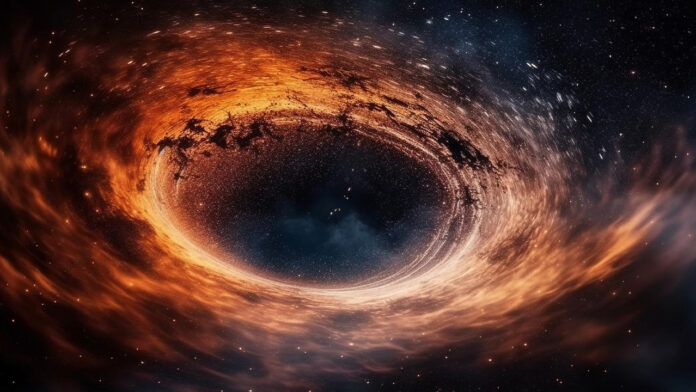In the vast cosmic tapestry, few entities captivate the imagination and challenge our understanding of the universe like black holes. These enigmatic cosmic phenomena, born from the gravitational collapse of massive stars, wield gravitational forces so intense that not even light can escape their grasp. In this exploration, we unravel the mysteries of black holes, delving into the science that surrounds them, their peculiar behaviors, and the profound impact they have on the fabric of the cosmos.
Defying the Laws of Gravity
Formation of Black Holes: Black holes are born from the remnants of massive stars that undergo gravitational collapse. When a star exhausts its nuclear fuel, it can no longer withstand the force of gravity, leading to a collapse that forms a singularity—a point of infinite density—at its core.
Event Horizon: The boundary around a black hole, beyond which nothing can escape its gravitational pull, is known as the event horizon. Once an object crosses this point, it is destined to be consumed by the black hole.
The Gravity Well
Gravitational Pull: The gravitational pull near a black hole is so intense that it distorts space-time itself. This phenomenon, predicted by Einstein’s Theory of General Relativity, creates a gravity well from which nothing, not even light, can escape.
Effects on Nearby Objects: Objects in close proximity to a black hole experience tidal forces—uneven gravitational forces that can stretch and distort them. These effects are most pronounced near the event horizon.
Types of Black Holes
Stellar Black Holes: Formed from the collapse of massive stars, stellar black holes have masses ranging from about 3 to 10 times that of our sun. They are prevalent in the universe and play a crucial role in the life cycle of stars.
Supermassive Black Holes: Found at the centers of galaxies, supermassive black holes boast millions or even billions of times the mass of the sun. Their origins are still a subject of scientific inquiry, and their presence influences the dynamics of entire galaxies.
Bizarre Behaviors
Time Dilation: Intense gravitational fields near black holes cause time dilation—a relativistic effect where time appears to pass more slowly for an observer near the black hole compared to those farther away.
Spaghettification: As objects approach a black hole, tidal forces can stretch them into long, thin shapes—a phenomenon humorously referred to as “spaghettification.”
Observing the Unobservable
Invisible Entities: Black holes are inherently invisible, as they do not emit or reflect light. However, their presence can be inferred through the gravitational effects they exert on nearby visible matter.
Detecting Gravitational Waves: The groundbreaking detection of gravitational waves by LIGO (Laser Interferometer Gravitational-Wave Observatory) opened a new era in astronomy, allowing scientists to observe the mergers of black holes by measuring ripples in space-time.
The Paradox of Information Loss
Hawking Radiation: Proposed by physicist Stephen Hawking, Hawking radiation suggests that black holes can emit radiation and gradually lose mass over time. This theoretical process challenges the notion that information swallowed by a black hole is irretrievably lost.
Information Paradox: The fate of information consumed by a black hole remains a paradox in theoretical physics. Resolving this paradox is a key challenge in understanding the fundamental nature of black holes.
Stellar Collapse and Supernovae
Supernova Explosions: The formation of stellar black holes is often preceded by a dramatic event known as a supernova. The explosive death throes of massive stars result in the ejection of outer layers and the collapse of the star’s core.
Neutron Stars and Black Hole Formation: Depending on the mass of the collapsing star, the remnants may form a neutron star or, in the case of more massive stars, lead to the formation of a black hole.
The Role of Black Holes in Galaxies
Galactic Centers: Supermassive black holes are thought to reside at the centers of most galaxies, influencing the dynamics and structure of their host galaxies. The Milky Way, for instance, is believed to harbor a supermassive black hole known as Sagittarius A*.
Galactic Evolution: The interactions between supermassive black holes and surrounding matter play a crucial role in galactic evolution, affecting star formation, gas dynamics, and the overall structure of galaxies.
Unsolved Mysteries and Future Exploration
Quantum Gravity: The marriage of quantum mechanics and general relativity—known as quantum gravity—remains an unsolved challenge in understanding the behavior of matter near a black hole’s singularity.
Event Horizon Telescope: The Event Horizon Telescope, a global array of radio telescopes, captured the first-ever image of a black hole’s event horizon in 2019. Ongoing advancements in observational technology promise further insights into these cosmic enigmas.
Conclusion: The Cosmic Odyssey Continues
In conclusion, black holes stand as cosmic marvels that challenge our understanding of the very fabric of space and time. From the formation of stellar black holes in the aftermath of supernovae to the mysterious realms near supermassive black holes at galactic centers, these celestial entities continue to captivate astronomers and physicists alike. As technological advancements enable us to probe deeper into the mysteries of black holes, the cosmic odyssey unfolds, revealing new chapters in our quest to comprehend the most enigmatic entities in the universe.

